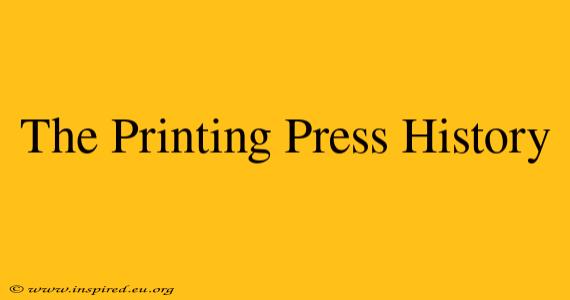The printing press stands as a monumental invention, forever altering the course of human history. Its impact on the spread of knowledge, the rise of literacy, and the shaping of modern society is undeniable. This article delves into the fascinating history of the printing press, exploring its evolution, impact, and lasting legacy.
From Woodblocks to Movable Type: The Evolution of Printing
Printing, in its earliest forms, existed long before Gutenberg. The ancient Chinese used woodblock printing centuries earlier, creating entire pages from carved blocks of wood. This method, while effective for producing images and text, was incredibly time-consuming and expensive. Each page required a new, meticulously carved block.
Gutenberg's Revolution: Movable Type
Johannes Gutenberg's innovation in the mid-15th century was revolutionary. He didn't invent printing, but he perfected the process using movable type. Instead of carving entire pages, Gutenberg created individual, reusable metal characters. This allowed for faster, more efficient, and significantly cheaper mass production of texts.
His invention wasn't solely technological. Gutenberg also developed a new ink that adhered better to paper and metal type, crucial for high-quality prints. He combined existing technologies in a groundbreaking way, leading to a paradigm shift in information dissemination.
The Impact of the Printing Press on Society
The consequences of Gutenberg's invention were profound and far-reaching. The printing press democratized knowledge, empowering individuals with access to information previously restricted to the elite.
The Spread of Literacy and Knowledge
Before widespread printing, books were painstakingly copied by hand, making them rare and expensive. The printing press dramatically reduced costs and increased availability. This led to a surge in literacy rates and a wider dissemination of knowledge across social classes.
The Rise of Nationalism and Reformation
The printing press played a vital role in the rise of nationalism and religious reform movements. Pamphlets and books could spread ideas quickly and efficiently, fostering a sense of shared identity and challenging established power structures. Martin Luther's 95 Theses, printed and distributed widely, sparked the Protestant Reformation.
Scientific Revolution and Enlightenment
The ability to quickly disseminate scientific discoveries and philosophical arguments fueled the Scientific Revolution and the Enlightenment. Scientists could share their findings more readily, accelerating the pace of scientific progress. The exchange of ideas across borders fostered intellectual growth and collaborative research.
The Printing Press Today: A Continuing Legacy
While digital technologies have largely replaced traditional printing for many purposes, the legacy of the printing press remains strong. It laid the groundwork for modern mass communication and information sharing. Its impact continues to shape our world.
Modern Printing Techniques
Modern printing utilizes advanced technologies, from offset lithography to digital printing. These techniques allow for high-quality, high-volume production of a wide range of materials, from books and newspapers to packaging and marketing materials.
The Enduring Power of Print
Despite the digital age, print materials continue to hold significant value. Books, magazines, and newspapers retain a tangible quality that resonates with readers. Print advertising still maintains effectiveness, reaching specific demographics and creating memorable impressions.
Conclusion
The printing press's history is a testament to human ingenuity and its transformative power. From its humble beginnings to its modern iterations, it has fundamentally reshaped communication, knowledge dissemination, and the structure of society. Its lasting legacy continues to influence our world in profound ways. Understanding its history provides crucial insights into the evolution of our globalized, information-rich world.
